Having gone through all of the faction cards from the core set, we finally come to the cards that have no faction, and can be used in any corporation or runner deck. While these cards may not be nearly as powerful as other cards, their versatility means that they can be used in a wide variety of situations, and as such, it is important to take a look at them.
Infiltration
On the surface, you might wonder why you would put this card into a deck. Gaining 2 credits for a cost of zero can be done much more easily with other cards (Magnum Opus and Easy Mark come to mind,) but it is the second ability that makes this worthwhile. Exposing a card means that you can see exactly what an unrezzed card is. So with this, you can check that one piece of ice on HQ before you make your Account Siphon, or you can see whether the card installed in a server that the corp advanced twice is either an agenda or a trap. Gaining this knowledge makes it easier for the runner to plan out their turn and means fewer wasted clicks.
Trivia: The flavor text and artwork are a reference to Android: Infiltration, a spinoff board/card game where a team of criminals are infiltrating a corporation in order to steal data on a prototype new android. These two, John "Animal" McEvoy and Monica Singh, are two of the playable characters.
Pair cards: Blackguard
Sure Gamble
This cards is in almost every single runner deck ever built, with good reason. Since you start the game at 5 credits, you can play this on your first turn to go up to 9 credits. This 4 credit gain is likely to be the greatest amount of credits you can gain in one click. As such, it is exceedingly good to use this for any purpose: installing cards, making a run, or just gaining even more credits.
Trivia: Yes, this is a reprint. The original card in the Netrunner CCG was called Score!
Pair cards: Prepaid VoicePAD, Order of Sol
Crypsis
This is an interesting card. Since it is an AI, you can use this on almost any piece of ice. The two major downsides are the starting strength of 0, meaning it will be expensive to break any high strength ice, and the fact that it has to be charged with virus counters. While it is not exactly the kind of card you would build a deck around, the versatility of this means it might be worth running a copy of it in your deck so you can pressure runs early before you get your main breakers out.
Pair cards: Déjà Vu, Grimoire, Djinn, Virus Breeding Ground, Incubator, Hivemind
Access to Globalsec
While this card does not look like much, it has a rather niche use. 1 credit for an extra link strength is the cheapest way to boost your link so far. If your runner identity has a base link of 1, then you only need one of these to activate cloud breakers, which take up no memory if you have 2 or more link. Also, there are now a number of runner cards which allow you to force the corporation to make a trace against you, and if it is unsuccessful, you gain a benefit. So being able to boost your link for cheap helps out in decks that revolve around taking advantage of those cards.
Pair cards: cloud breakers, Underworld Contact, Security Chip, Security Nexus, Citadel Sanctuary, Another Day, Another Paycheck, The Archivist
Armitage Codebusting
While I derided Infiltration as a bad way to gain 2 credits, this is actually a fairly decent way to expand a deck's economy. It only costs 1 credit to install, which means that from having no credits, you can gain a credit and then install this. If you have 2 clicks left, you could take 4 off of it. The result is the same as if you spent your turn clicking for credits, but you would still have 8 credits left on this for the future. So if you need some extra cash, this is not a bad card to add in.
Trivia: Another reprint here. The original card was called Short-Term Contract, but other than that, it functions in exactly the same way as this.
Pair cards: anything
Priority Requisition
Using expensive ice is a double-edged sword. Sure, it can be expensive for the runner to deal with, but the cost of bringing it online can set you back, and also may leave other servers vulnerable. With this card, you can bring a piece online without paying the rez cost, or any additional costs. With this, you could rez an Archer without having to give up an agenda. Or you could rez something very expensive, such as Hadrian's Wall. The downside is that the runner will know what that ice is, so you give up the element of surprise. Still, if you think you might need to bring something online for cheap, this is not a bad way to do so while moving you closer to winning.
Trivia: This is a reprint, right down to the name Priority Requisition.
Pair cards: expensive ice
Private Security Force
With an advancement requirement of 4 for 2 agenda point, this card is not great standing alone. But, if you can tag the runner, then you can do a point of meat damage to them by spending a click. This could be used to put them down into range for a Scorched Earth. Granted, the runner can replenish cards faster than you can remove them, and if they only have one tag, then this can be turned off easily. However, scoring this means they have to be wary of taking any tags.
Trivia: There are a number of agendas out of the Netrunner CCG that allow the corporation to do meat damage to the runner if they are tagged. However, the one that is closest to this one is probably On-Call Solo Team, although that one is worth 3 agenda points instead of 2.
Pair cards: Breaking News, SEA Source, Midseason Replacements, The Cleaners, Hard-Hitting News
Melange Mining Corp.
An intriguing card. For 1 credit and an entire turn, you can get 7 credits. Of course, the biggest vulnerability is the low trash cost. If you leave this out in the open, it probably will not survive more than one turn. Adding some protection to this is a good idea, although you might not want to base your entire economy on this. Still, it makes for a decent burst.
Trivia: The name and the flavor text are both references to Frank Herbert novel Dune, where an addictive drug called Melange is necessary for space travel. The are also repeated statements that "the spice must flow." Oh, and this card is a reprint. The original card was called South African Mining Corp, although that card cost 0 to rez and granted 6 credits for 3 actions.
Pair cards: Efficiency Committee, Jeeves Model Bioroids
PAD Campaign
At a cost of 2 credits, gaining just 1 credit seems like a drawback. This card has to stay in play for 2 turns before it has broke even with the cost. But with a trash cost of 4, the runner may choose not to remove this immediately, even if it has no defenses in front of it. So if you need some cash every turn, this is a good way to do so.
Trivia: PAD is an acronym for "personal access device," a futuristic invention that combines the functions of a smart phone and a computer.
Pair cards: Breaker Bay Grid, Mumba Temple
Hedge Fund
The corporation equivalent of Sure Gamble, this card makes up the standard turn 1 play of the corporation: install ice on HQ and R&D, and play Hedge Fund. Just like Sure Gamble, gaining 4 credits in 1 click is very powerful. Also, this card is a transaction, so if you are playing as Weyland Consortium: Building a Better World, you'll gain an extra credit.
Trivia: Just like Sure Gamble, this card is also a reprint. The original card was called Accounts Receivable.
Pair cards: anything
Enigma
This card is a very good piece of early game ice. It has a low rez cost, meaning you can bring it online easy enough. But the subroutines are of particular interest. The first one forces the runner to lose a click if they have any left. If they hit this in the early game and are unable to break it, losing the click may end their turn early. Of course, if they are running on the last click, then they can ignore that subroutine, making this potentially cheaper to break. And of course, if they have Yog.0 in play, they can get through this for free.
Pair cards: Chum, Heinlein Grid, Encrypted Portals
Hunter
A very cheap porous sentry. This card could potentially land a tag on the runner. Of course, the runner has a number of options in dealing with this. They could break the one subroutine, or match the trace, or just take the tag. As such, ideally you want to place this card well to get the most out of it.
Pair cards: Improved Tracers, Pachinko, Data Ward
Wall of Static
Sort of the standard for walls. Costs 3 to rez, has 3 strength and one end the run subroutine. Works decently in the early game to stop runner, and should be slightly taxing on them for the rest of the game.
Trivia: Pretty much a reprint. The Netrunner CCG has a card named Wall of Static which has almost exactly the same statistics, except it has 2 strength instead of 3.
Pair cards: Superior Cyberwalls, Sub Boost
And that is it for the core set. Next time, we begin the Genesis Cycle and find out What Lies Ahead.
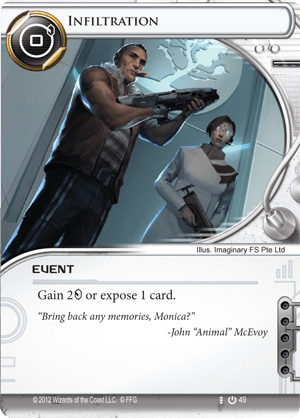

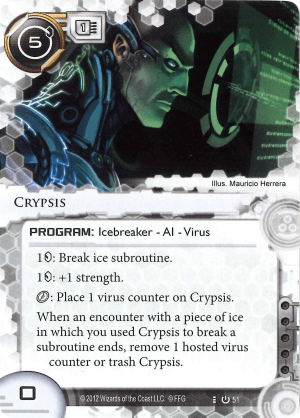
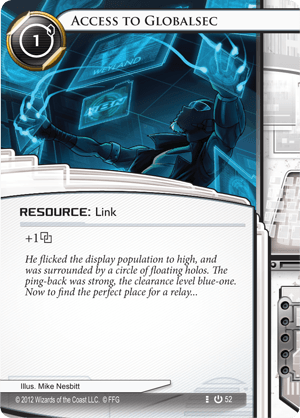
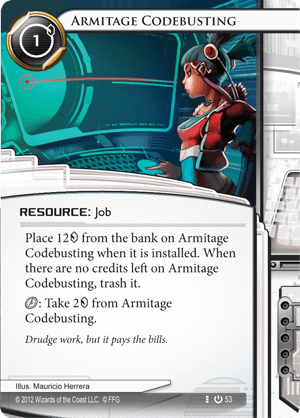
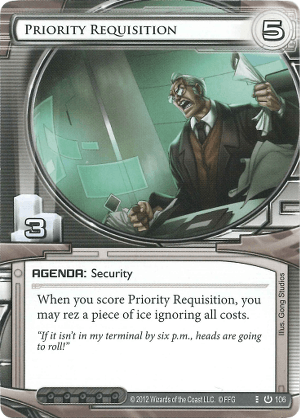
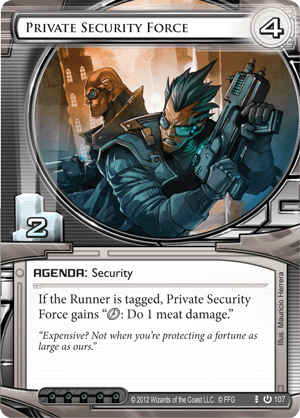
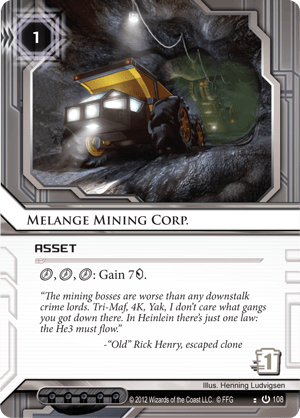
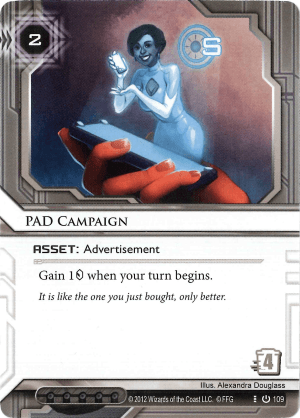
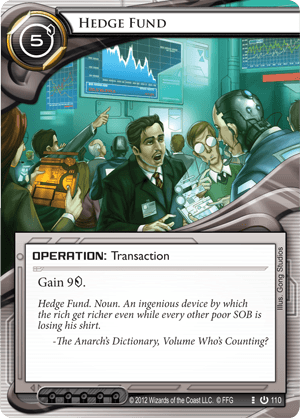
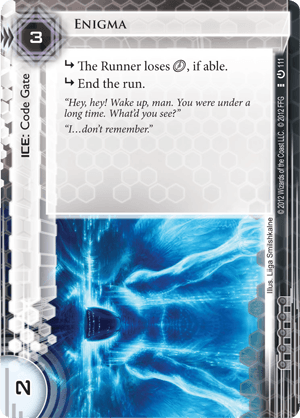
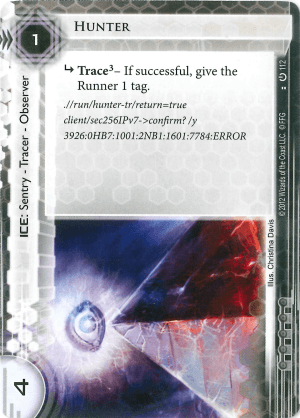
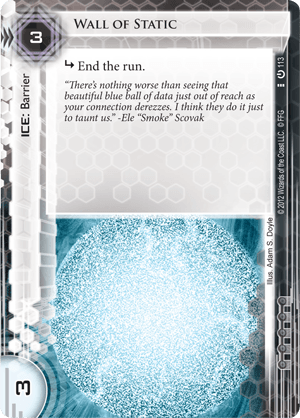
No comments:
Post a Comment